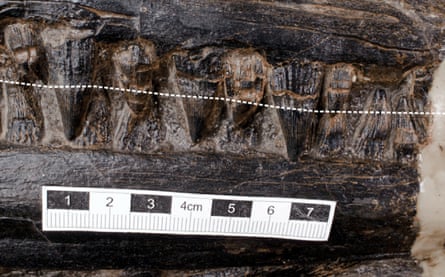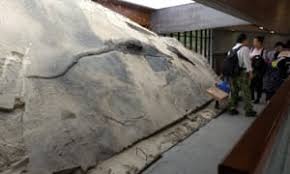Discovery from Middle Triassic sheds new light on ocean predators millions of years ago
Source: The Guardian
Fresh evidence of the dog-eat-dog world of prehistoric oceans has been revealed by fossil hunters who have unearthed the remains of a giant marine reptile with another huge beast in its stomach.
Dug up in south-western China in 2010, the animals are thought to have lived in the Middle Triassic.
The team say the larger fossil, nearly 5 metres in length, is the remains of an ichthyosaur – marine reptiles with a long snout, similar in appearance to a dolphin – while the smaller fossil within it is the middle section of a species called Xinpusaurus xingyiensis, a type of marine reptile known as a thalattosaur that was usually about 4 metres long.
The international team of researchers say the ichthyosaur, Guizhouichthyosaurus, was not previously thought to have been a top predator – not least because its teeth lacked cutting edges and were thought best suited to grasping soft prey such as squid. But the findings suggest otherwise, revealing its last meal was a creature larger than an adult human.

“It likely represents the oldest record of megafaunal predation by a marine reptile,” the team wrote in the journal iScience, adding the discovery also broke records for the longest prey of such creatures.
The findings could change the reputations of other creatures too: “There were many more Mesozoic marine reptiles with similar grasping teeth, so megafaunal predation was likely more widespread than presently conceived,” the team said.
While the team said it remained unclear whether the ichthyosaur sought out the thalattosaur, or if it simply scavenged the meal, they said the former was more likely.
“If a predator other than Guizhouichthyosaurus killed the thalattosaur in question, then it would be strange for the nutritious trunk and limbs to be left intact by the predator,” they said. Among further evidence, they noted decomposition of a dead creature would have been fast, the head and tail of the thalattosaur appear to have been torn off before eating, while the thalattosaur was likely ingested near the surface as it would have taken time to swallow.
Dr Nick Fraser, a palaeontologist at National Museums Scotland who was not involved with the work, said it could often be difficult to be sure one creature had been eaten by another, rather than two fossils simply lying on top of each other, but that did not appear to be the case for the new find.
“In this case I find it very convincing that the Xinpusaurus is indeed the Guizhouichthyosaurus’ last meal,” he said, adding the peg-like teeth of the larger reptile made it surprising it could grasp and swallow the thalattosaur.
“I agree with the authors that [Xinpusaurus] was likely captured live rather than scavenged, but maybe [the thalattosaur] was not a healthy individual,” he said.
“In any event, I think it is clear that it was a step too far for the ichthyosaur. As such this might represent a rather uncommon event in a day in the life of a Triassic marine reptile. But it does rather magically bring to life a cameo of animal interactions in the seas approximately 230m years ago.”
Source: The Guardian

































Leave a Comment
You must be logged in to post a comment.